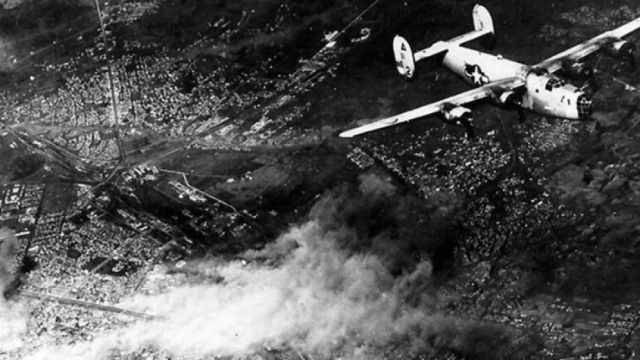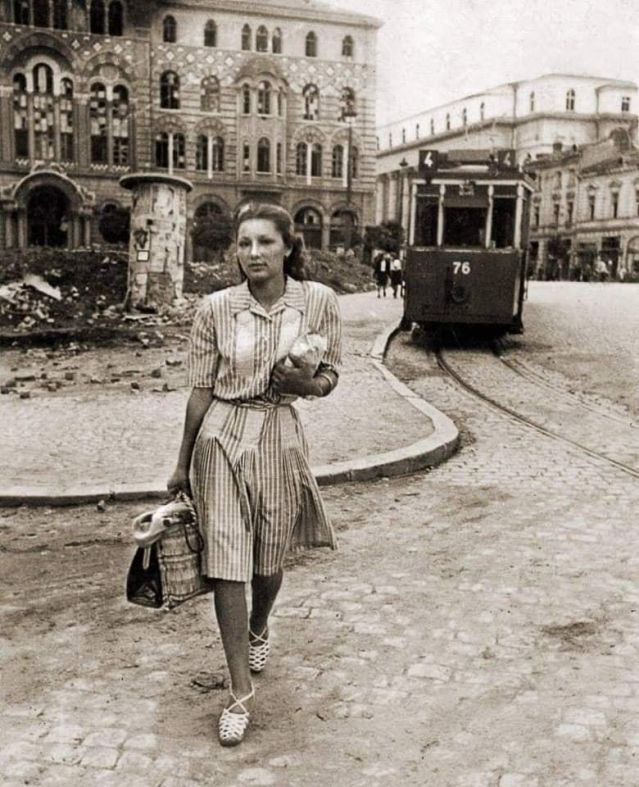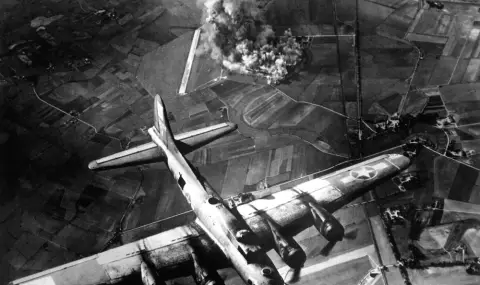On January 10, 1944, the most destructive bombing of Sofia took place during World War II.
Over 1,700 bombs were dropped on the capital, hundreds were killed and injured, mostly civilians. The destruction was extensive.
During the day, American bombers carried out raids, and at night - British planes.
Around 12:30 p.m. At noon, a formation of about 200 American B-17 and B-24 bombers is on the approaches to Sofia.
They are accompanied by no less than 100 P-38 “Lightning” biplane fighters.
The bombers strike Sofia at 12.35 p.m., and at 10 p.m. 80 British “Lellington” bombers repeat the strike and drop another 1,000 bombs, mainly on the eastern neighborhoods.
750 people are killed, about 700 are injured.
3,304 buildings are completely destroyed, partially – 427.
The communication and water supply networks were cut off, the southern wing of the National Theater, the Bulgarian Academy of Sciences building, neighboring buildings were on fire....
This was the first joint day-night attack, in which the British aviation attacked at night, and the American aviation, which had better fighter cover, attacked during the day.
The day attack was carried out by 330 American aircraft.
The city was attacked by two American bomber regiments, B-24 and B-17 "Flying Fortresses" – about 220 bombers and 110 Lightning fighters.

The bombing was carried out at 1:00 p.m. when the bombers, the so-called “Flying Fortresses“, attacked.
The participation of 143 B-17 Flying Fortresses, 37 B-24 Liberators) and 110 P-38 Lightning fighters was confirmed.
A total of 73 aircraft took off against them from Bozhurishte, Vrazhdebna and Marno Pole near Karlovo – 43 Bulgarians from the 6th Fighter Regiment and 30 German fighters.
From the Sofia airfields take off - 2/6 Fighter Eagle with 23 Dewoitine D.520 and 3/6 Fighter Eagle with 16 Me-109G[47] and from Karlovo one wing (a squadron of four fighters) Dewoitine D.520 from 4/6 Fighter Eagle, led by candidate non-commissioned officer Todor Rozev.
The German squadron I./JG 5 “Eismeer“ also takes off in the defense of Sofia with 30 Me-109G fighters, led by its commander Capt. Gerhard Wengel.
The air defense fired 1,958 shells. In the air battle, the Bulgarians shot down 6 "flying fortresses" and 5 fighters, the Germans shot down 3 more bombers, the defenders of Sofia suffered 2 casualties - non-commissioned officer Simeon Mihaylov was killed /his plane suddenly flew to the ground and crashed near the village of Malo Buchino, probably losing consciousness due to severe sinusitis/ and the German fighter captain Gerhard Wengel, killed near Radomir in a battle with several enemy fighters.
3 more German pilots were wounded: Oberleutnant Robert Müller and Oberfeldwebel Kalweit, Non-commissioned Officer Holtkötter. [48] At 10 p.m. that night, Sofia was attacked by about 80 more British aircraft, and despite 1,310 anti-aircraft shells fired, the enemy managed to inflict further damage on the city.
As a result of the day and night attack on Sofia, 947 people were killed and 710 were injured.
3,731 buildings were severely damaged - 93 state and 3,211 private buildings were destroyed, and 427 were partially destroyed. A total of 1,784 bombs were dropped on Sofia.
The brutal airstrikes on January 10 greatly disrupted public life in the capital and evacuation began.

By January 16, 300,000 residents had left the city.
However, the Bulgarians made their enemy, confident in their vast numerical superiority, pay the heaviest price.
The commander of the 3/6th Fighter Eagle, Captain Chudomir Toplodolski, and his men plunged into the armada and in a matter of minutes, three P-38G Lightnings were shot down. and in the course of the pursuit, eight more left the area, marking the sky with their smoke trails, one of the bombers was "shot" by the accurate fire of Lieutenant Tsviatko Zagorski, separated from the group and crashed in the vicinity of the village of Radibosh, and the Devotins attacked frontally, the result of their "cavalry" attack was - three more bombers began to smoke, trying to keep their place in the battle order, which no longer exists.
B-17F "flying fortress" with commander Lieutenant Finch had the most damage and crashed near the village. Kladnitsa, Pernishko.
The first wave of American bombers could not stand it and turned their course towards Italy, taking the remaining crews with them.
Their bombs were dropped without the necessary aiming, with the clear desire to leave the skies over Sofia as quickly as possible.
The BBC reports that 31 American planes did not return to their bases after the “mission“ over the Kingdom of Bulgaria.
On January 24, a new attack was launched on Sofia, but on that day nature was on the side of the people of Sofia.
The entire Sofia field was shrouded in a thick layer of fog.
The planes of the 15th Air Force of the United States did not have the equipment for blind bombing, which the night bombers of the Royal Air Force (RAF) had.
And after circling over Vitosha for 45 minutes, the bombers took off in different directions.
One group bombed Skopje, then in the territory of the Kingdom of Bulgaria.
Another formation of 84 bombers hit Vratsa. 124 people were killed and 250 people were injured, epicentre.bg recalls.
Fighters descended low and fired on the city with their on-board weapons. Other settlements in Northern Bulgaria were also bombed. In total, about 800 bombs were dropped over the country.
After a lull, the bombing was renewed on the night of March 16 by a British tactical bombing group. It dropped about 4,000 incendiary magnesium bombs on the central part of the capital, causing over 70 fires.
A second strike followed during the night on targets in the area of the Central Railway Station and in the area of the Lozenets district.
45 buildings and structures were destroyed and 13 were affected, with the casualties estimated at 19 killed and 76 injured. The deadliest and most powerful attack
On the clear, cloudless day of March 30, the most brutal bombing followed. The bombing formation tasked with bombing Sofia consisted of about 450 Liberator, Flying Fortress, Mitchell and Halifax bombers. They were accompanied by 150 Lightning fighters. 3,000 destructive and a large number of incendiary bombs were dropped, and 3,575 buildings were destroyed. 139 people died, over 2,000 fires broke out.
The buildings of the National Theater, the Council of Ministers, the Ministry of Justice and Finance, the National Library, the "Bulgaria" hotel, the State Printing House, the Holy Synod and other "military sites" burned for a long time.
In ashes lay "Dondukov" Blvd., "Targovska" St. (today "Pirotska" St.), "Maria-Luiza" St., "Klementina" St. (today "Al. Stamboliyski" Blvd.), " “Lege”, “Battenberg” Square...
The grim tally: - 45,265 destructive and incendiary bombs were dropped. Some of them were timed to explode later, when people had left their hiding places.
- Toy bombs and pens were also used, designed to kill and maim children.
- Over 2,477 people died, 99 percent of whom were civilians, women and children. The wounded are twice as many.
Over 12,000 buildings were destroyed.
The 4,350-ton bomb load dropped on the capital collapsed nearly 1/4 of its buildings.
The material damage reaches the astronomical sum of 24 billion leva. Democrat Churchill welcomes the data from the destructive bombings over Bulgaria with the words: “Excellent!”.
The 4,350-ton bomb load dropped on the capital collapsed nearly 1/4 of its buildings.
The material damage reaches the astronomical sum of 24 billion leva. Democrat Churchill welcomes the data from the destructive bombings of Bulgaria with the words: “Excellent!”.
